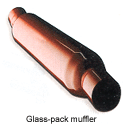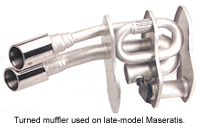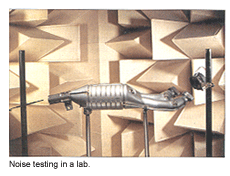Is a muffler nothing more than a steel can with some baffles and tubes inside? That’s how most mufflers look, but there’s a lot more to muffler science than meets the eye.
A muffler’s job is to muffle sound. That’s why we call them mufflers. In England they’re called silencers. Regardless of the name, they all do something to change, dampen or absorb the noise-producing pressure pulses in the exhaust. Some mufflers do it by creating resistance with baffles and louvered tubes. Resistance to flow causes the pressure pulses to stack up and dissipate, lowering their energy and the level of sound they produce (which is measured in decibels).
Some mufflers turn the pressure pulses against themselves by rerouting and redirecting the exhaust through “tuning” chambers. By carefully adjusting the volume and length of the chambers, the pressure pulses can be attenuated within certain frequencies.
Another trick that’s used to control noise is to pack areas around the louvered tubes inside the muffler with strands of fiberglass (called “roving”). The sound-absorbing properties of the fibrous material acts like insulation to further absorb and dampen energy in the exhaust pulses.
 More recently, the science of acoustics and gas flow dynamics has yielded some new muffler designs that use “reflective sound cancellation” (RSC) technology. Such mufflers eliminate unwanted sound frequencies without the use of restrictive baffles or packing material. An air gap in the tube allows sounds waves to bounce back in forth in such a way that they cancel one another. The idea here is get pressure pulses that are 180 degrees out of phase with each other to collide and cancel each other out.
More recently, the science of acoustics and gas flow dynamics has yielded some new muffler designs that use “reflective sound cancellation” (RSC) technology. Such mufflers eliminate unwanted sound frequencies without the use of restrictive baffles or packing material. An air gap in the tube allows sounds waves to bounce back in forth in such a way that they cancel one another. The idea here is get pressure pulses that are 180 degrees out of phase with each other to collide and cancel each other out.
HUFF AND PUFF
When an engine is running, it blows out puffs of exhaust after every cylinder fires. When each exhaust valve opens, hot exhaust gases are shoved past the valve with explosive force. The gases are still expanding as they enter the exhaust manifold and create a pressure wave that pushes rearward through the entire exhaust system. Each pressure pulse represents noise that increases or decreases in frequency with the rpm of the engine.
BACKPRESSURE AND FLOW
The pressure pulses in the exhaust also create backpressure in addition to noise. As the volume of gas passing through the exhaust system increases with rpm and throttle opening, pressure backs up in the system because of resistance to flow created by the pipes, catalytic converter, muffler and/or resonator.
As a general rule of thumb, there should be less than 1.5 psi of backpressure in most exhaust systems at idle. This can be measured by attaching a pressure gauge to the exhaust system anywhere ahead of the converter (an air pipe connection on the exhaust manifold, a diverter valve connection, oxygen sensor connection, even the EGR valve connection). If there’s a restriction in the exhaust, it will usually cause a higher than normal back pressure reading and a corresponding drop in intake vacuum.
One of the easiest ways to diagnose a clogged converter or muffler is to connect a vacuum gauge to the intake manifold and watch the vacuum readings at idle. Most engines will have 16 or more inches of vacuum at idle. If the reading is lower than normal, and/or continues to drop the longer the engine runs, it means pressure is backing up in the exhaust and is limiting the engine’s ability to exhale. Eventually, the back up will suffocate the engine and cause it to stall if the exhaust system is not passing any gas.
 MEASURING MUFFLER PERFORMANCE
MEASURING MUFFLER PERFORMANCE
If you have a dyno you can make a series of test runs and measure the engine’s power output with different mufflers behind it. Or, you can take the vehicle to the drag strip and see which muffler gives the fastest E.T.
But major muffler manufacturers use a more scientific approach. They use test equipment that measures airflow under controlled conditions. The equipment they use is similar to that which a performance engine builder would use to measure airflow through a cylinder head, intake manifold or carburetors. The only difference is that they are measuring airflow through a muffler on a test stand. The purpose of such testing is to evaluate the flow characteristics of a muffler so engineers can develop a replacement muffler that flows the same or better than the original equipment muffler or a competitive muffler.
In one laboratory test setup we saw at a leading aftermarket exhaust manufacturer’s facility, mufflers were fed a simulated exhaust stream of 200 standard cubic feet per minute. This is roughly equivalent to the exhaust output of a 200 cubic inch (3.3 liter) engine running at 3,400 rpm. Backpressure (in inches Hg) was measured at the muffler inlet, and a microphone recorded the sound level at the muffler’s outlet in decibels. Using this setup, the manufacturer can benchmark and compare the performance of their own mufflers against OEM mufflers and competitive mufflers.
Most stock mufflers do a great job of reducing noise, but they are also restrictive and increase backpressure. The typical stock muffler produces about three inches Hg of backpressure at a flow rate of 200 cfm, but jumps to 16 inches Hg when the flow rate is increased to 300 cfm. This really hurts fuel economy and performance.
Many performance mufflers, on the other hand, do a great job of reducing backpressure, but aren’t very good at muffling noise. A straight-through “glass pack” style muffler is about as simple as it gets and offers little restriction to the flow of gas. But the louvered tube and the packing inside may not provide the same degree of noise absorption as an “S” flow muffler or one that has multiple tubes, baffles and chambers.
 Another difference that becomes obvious when various brands and types of mufflers are compared on a flow bench is that some flow much better than others. Higher flow numbers mean less backpressure, but flow numbers alone do not tell the whole story because sound control is also important. Even so, two performance mufflers that look identical on the outside and have the same size inlet and outlet pipes can have very different flow numbers. In one test, three competitive performance mufflers for a Camaro were flow tested at the same pressure drop across the muffler (20 inches H2O). Brand “A” flowed 700 cfm, Brand “B” flowed 940 cfm and Brand “C”flowed 570 cfm. That’s quite a difference.
Another difference that becomes obvious when various brands and types of mufflers are compared on a flow bench is that some flow much better than others. Higher flow numbers mean less backpressure, but flow numbers alone do not tell the whole story because sound control is also important. Even so, two performance mufflers that look identical on the outside and have the same size inlet and outlet pipes can have very different flow numbers. In one test, three competitive performance mufflers for a Camaro were flow tested at the same pressure drop across the muffler (20 inches H2O). Brand “A” flowed 700 cfm, Brand “B” flowed 940 cfm and Brand “C”flowed 570 cfm. That’s quite a difference.
Though some customers want a louder, deeper exhaust sound (and will gladly pay extra for it!), most motorists prefer a quiet exhaust, but would be happy to have a muffler that provides the best of both worlds: good noise control with less backpressure to improve flow and horsepower. Some aftermarket muffler designs can do just that, reduce backpressure from 10% to as much as 65% over a stock OEM muffler while still providing almost the same noise control as before.
A straight pipe, by comparison, produces almost no change in backpressure and does nothing to reduce noise.
HIGH PERFORMANCE MUFFLERS & HIGHER PROFITS
Polished stainless steel mufflers and free flowing cat-back exhaust systems are a hot bolt-on upgrade opportunity, and can be easily installed on most cars, SUVs and light trucks. The most popular applications for these kinds of upgrades are the sporty cars that teens, twentysomethings and even some over thirties are driving, such as Honda Civic, Accord and Prelude, Acura Integra and RSX, Mitsubishi Eclipse and Lancer, Ford Focus, Chevy Cavalier, Mazda Miata, RX-7 and RX-8, Nissan 300ZX and 350Z, Toyota Celica, Matrix and Scion, Subaru WRX, and VW GTI, Golf, Passat and Beetle.
Of course, the market for performance exhaust products certainly isn’t limited to these makes and models only. Almost any vehicle might be a prospect for an exhaust upgrade if the owner wants more power or wants to customize the appearance of their vehicle.
Unlike your typical exhaust customer who doesn’t want to spend a nickel more than is absolutely necessary to replace a muffler, your typical performance customer actually enjoys spending money to accessorize and customize his or her vehicle. Consequently, you can sell up and don’t have to haggle price. You can sell this type of customer a performance muffler that may cost two or three times as much as a stock replacement muffler.
Better yet, don’t wait for pipes and mufflers to fail to make a sale. Some people will have the stock mufflers replaced with performance mufflers as soon as they buy a new car or truck.
Most premium quality performance mufflers and pipes today are made of stainless steel (usually aircraft-quality T-304), but there are lesser quality grades of stainless that sell for less. Aluminized steel is another option, but it doesn’t have the durability of stainless. Even so, aluminized steel is much better than plain uncoated steel or painted steel.
Most performance pipes are formed with mandrel bends which do not narrow the diameter of the pipe where it curves. This reduces unwanted restrictions and keeps the exhaust flowing freely.
Most premium mufflers and systems are also plasma or TIG welded to maintain the strength and corrosion resistance of the stainless steel. Some manufacturers also use a process called “bulge forming” or “hydroforming” to form steel sheets into molded shapes using extremely high fluid pressure.
DIRECT FIT OR UNIVERSAL?
Stock and performance mufflers are available in both direct-fit or universal configurations. You’ll find the greatest selection in universal products, which can be adapted and made to fit almost any vehicle. But the main drawback of one-size-fits-all mufflers is that they sometimes require cutting and welding pipes, and fabricating hangars and mounts.
When the stock muffler is removed, the existing pipe may have to be cut, shortened or lengthened. If the pipes are getting weak, they may also have to be replaced to complete the installation. New hangers are often necessary to support the muffler, or existing hangars may have to be repositioned to provide proper support and keep the system from flexing or rattling. Clearance may be another issue, especially with large oversized muffler cans that are not the same size, shape or length as the original muffler.
Most of these modifications are not difficult or expensive to make, but they do take time so be sure to take that into account when pricing the job.
Direct fit mufflers usually don’t require any modifications or changes because they are designed to replace the stock muffler perfectly. Most are a simple bolt-in installation that connect to existing pipes and have mounts that line up with the stock hangars. The major drawback with direct-fit custom mufflers is limited availability for less popular models. Unless a vehicle is really popular, you may have a hard time finding a direct-fit performance muffler for it.
Sound quality is something that’s harder to control with universal-fit mufflers than direct fit mufflers which have been engineered for a specific vehicle application. Different engines sound differently and produce different frequencies and harmonics in their exhaust systems. So don’t expect a universal muffler to sound exactly the same regardless of what kind of vehicle is it installed on. It won’t.
Some performance mufflers are tunable in that they have removable baffles. The driver can change the sound by adjusting or removing the baffles.












